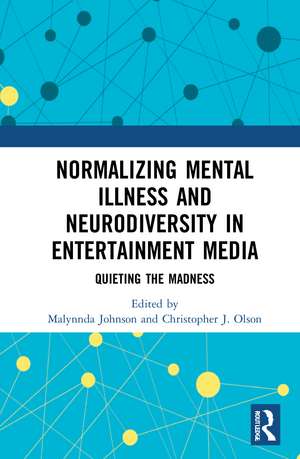Normalizing Mental Illness and Neurodiversity in Entertainment Media: Quieting the Madness
Editat de Malynnda Johnson, Christopher J. Olsonen Limba Engleză Paperback – 9 ian 2023
| Toate formatele și edițiile | Preț | Express |
|---|---|---|
| Paperback (1) | 296.06 lei 3-5 săpt. | +21.63 lei 4-10 zile |
| Taylor & Francis – 9 ian 2023 | 296.06 lei 3-5 săpt. | +21.63 lei 4-10 zile |
| Hardback (1) | 935.38 lei 3-5 săpt. | +22.24 lei 4-10 zile |
| Taylor & Francis – 20 apr 2021 | 935.38 lei 3-5 săpt. | +22.24 lei 4-10 zile |
Preț: 296.06 lei
Nou
Puncte Express: 444
Preț estimativ în valută:
56.66€ • 58.79$ • 47.36£
56.66€ • 58.79$ • 47.36£
Carte disponibilă
Livrare economică 24 februarie-10 martie
Livrare express 07-13 februarie pentru 31.62 lei
Preluare comenzi: 021 569.72.76
Specificații
ISBN-13: 9780367762254
ISBN-10: 0367762250
Pagini: 232
Dimensiuni: 156 x 234 x 18 mm
Greutate: 0.43 kg
Ediția:1
Editura: Taylor & Francis
Colecția Routledge
Locul publicării:Oxford, United Kingdom
ISBN-10: 0367762250
Pagini: 232
Dimensiuni: 156 x 234 x 18 mm
Greutate: 0.43 kg
Ediția:1
Editura: Taylor & Francis
Colecția Routledge
Locul publicării:Oxford, United Kingdom
Public țintă
Postgraduate and UndergraduateCuprins
1. Introduction: Why depictions of mental illness matter 2."Remember what Dr. Lopez said": Portrayals of mental health care in Nickelodeon’s The Loud House 3."And I suffer from short-term memory loss": Understanding presentations of mental health in Pixar’s Finding Nemo and Finding Dory through communication theory of identity 4.Family narratives and mental illness in This is Us 5.Cognitive differences in Star Trek: The case and evolution of Reginald Barclay 6.Popular culture and the (mis)representation of Asperger’s: A study on the sitcoms Community and The Big Bang Theory 7.Psychopath, Sociopath, or Autistic: Labeling and framing the brilliance of Sherlock Holmes 8.When Saga Norén meets neurotypicality: A liminal encounter along The Bridge 9.The Girl on the Swing: An analysis of cues and depression in Joe Wright’s Pride and Prejudice (2005) 10.Depictions of depression and eating disorders in My Mad Fat Diary 11."Portraying real feelings with comedy on top": Postpartum depression storylines and domestic sitcoms 12.Ruby Wax: Comedy, celebrity capital, and (re)presentations of mental illness 13.Post-traumatic stress disorder in the films Taxi Driver and You Were Never Really Here: A comparative progressive approach 14.Bipolar and Shameless: Showtime’s portrayal of living and working with bipolar disorder 15.Wrestling with eating disorders: Transmedia depictions of body issues in WWE’s women’s professional wrestling 16.Conclusion: Destigmatizing mental illness and neurodiversity in entertainment media
Notă biografică
Malynnda Johnson is an assistant professor of Communication at Indiana State University, USA, and the author of HIV on TV: Popular Culture’s Epidemic.
Christopher J. Olson is completing his doctoral research at the University of Wisconsin–Milwaukee, USA. He is the co-author of Possessed Women, Haunted States: Cultural Tensions in Exorcism Cinema and the co-editor of Making Sense of Cinema: Empirical Studies into Film Spectators and Spectatorship; Heroes, Heroines, and Everything in Between: Challenging Gender and Sexuality Stereotypes in Children’s Entertainment Media; and Convergent Wrestling: Participatory Culture, Transmedia Storytelling, and Intertextuality in the Squared Circle.
Christopher J. Olson is completing his doctoral research at the University of Wisconsin–Milwaukee, USA. He is the co-author of Possessed Women, Haunted States: Cultural Tensions in Exorcism Cinema and the co-editor of Making Sense of Cinema: Empirical Studies into Film Spectators and Spectatorship; Heroes, Heroines, and Everything in Between: Challenging Gender and Sexuality Stereotypes in Children’s Entertainment Media; and Convergent Wrestling: Participatory Culture, Transmedia Storytelling, and Intertextuality in the Squared Circle.
Descriere
This volume examines the shift towards positive and more accurate portrayals of mental illness in entertainment media, asking where these succeed and considering where more needs to be done.
